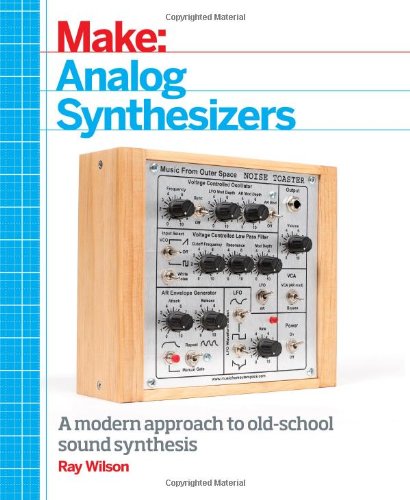A couple of months ago I purchased the book Analog Synthesizers by Ray Wilson. I was intrigued by the book and quickly decided to build the beginners kit of a DIY Analog Synthesizer presented in the book, the Noise Toaster.
I already had a plastic enclosure and a bunch of components, so I decided to order just the PCB from Ray Wilson, and not the whole kit. Ray Wilson is sort of a DIY analog synth guru and runs the web page http://www.musicfromouterspace.com/. The web page consist of all the information you need to build the Noise Toaster. However, I highly recommend to buy the book. It is well written, and I think the guy deserves some extra dollars for running his highly informative web-page.
The Noise Toaster consists of about 150 components, and is a fairly easy build. The only thing i forgot while ordering parts was that the design uses a lot of E24 resistors (which I did not have) and some bipolar capacitors (which are hard to get). Besides that, the components are fairly standard.
The only problem I had after the assembly was that the white noise generator did not work at all. I traced it down to the 2n3904 transistor Q5 which was not actually generating noise. I recommend to breadboard the white noise generator to make sure you select a 2n3904 which generates sufficient white noise. Two of the transistors I tried did not actually work as white noise generators. After soldering up the PCB and mounting the switches and pots, I fired it up and enjoyed the nice sound of the synth with all its squeals and noises.
The Noise Toaster runs of a 9V battery, which must be mounted securely inside the box. I downloaded a design for a 9V battery holder from Thingiverse, printed it on my 3D-printer and "glued" it to the bottom plate with sugru. For the speaker, I drilled a 50mm hole and mounted the speaker (again with sugru).
Since my plastic enclosure was way smaller that the design presented in the book, I had to design my own front panel. I did this in gimp based on Wilsons design. As I do not have a laminating machine, I printed the front panel on a 20x15cm photo paper and cut it to its proper size. It is not scratch-safe, but seems to work just fine.
The next step is to build some additional synth boxes to accompany the toaster. Together they will rule the world of noisy analog music.






Nice build! It looks great, and thanks for sharing about the weak points on the noise generator. You know anything about putting midi in on that ?
ReplyDeleteThank you. The VCO in the toaster does not hold its tuning very good, so adding midi won't do much for playing music. However, there might be possible to run some effects using midi clock, creating some hefty beats. I have not tried this but an arduino with a D/A might do the trick.
ReplyDeleteI would just send it control voltages with something like a microbrute. This would require the CV input mods but they are documented on rays web site. (Im sure poster knows this however a reader may not.)
ReplyDeleteWhat MFR produces that case?
I am not quite sure who produces the case. I just found it in my junk box.
ReplyDeleteIn my case 2N3904 didn't work as noise generator until 10.5V of power. Ironically it was the first part that started to work when I breadboarded it. Back then I powered it with 12V.
ReplyDeleteI had problems with VCO for some time because of couple mistakes in connections. Finally I fixed 'em and moved on to LFO and VCF. All this steps I did with 9V.
At last I connected WNgen and there were no noise. I disconnected WNgen apart from the rest circuitry and still no noise. Very frustrating! But then I guessed to increase voltage (I work with lab PSU) back to 12V and it started to hiss.
So I measured voltage drop on BE junction and it was 10,4V! It definitly will not work with 9V battery.
I then tried to replace Q5 with different types of NPN BJTs. BC337 works fine! It starts generating noise at 7V. I also tried some another types of BJTs, some of them produce more soft noise, not that grainy, it's a matter of taste which to use. I think it is a good idea to combine both transistors in circuitry with switch between them to choose what noise character I want to hear. :)